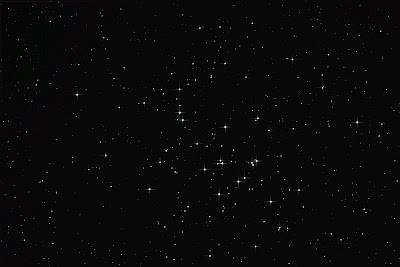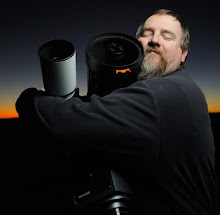
I have tried, but am still not totally enchanted with most open clusters. But if you like 'em, here's a shot of M44, the Beehive Cluster through the AT80EDT with the unmodded 350D for your enjoyment. 25 x 120 sec (out of 40 in the blowing wind!) @ ISO 800. Spikes from Astronomy Tools PS.
This famous cluster, Messier 44 (M44, NGC 2632), is also called Praesepe (Latin for "manger"), or the Beehive cluster. It is also one of the objects easily visible to the naked eye, and thus known since prehistoric times. Some ancient lore is associated with it: Greeks and Romans saw this "nebula" as the manger (Greek: Phatne) associated with two asses who eat from it, Asellus Borealis, the Northern Ass (Gamma Cnc; Spectral type A1 V, mag 4.7, distance 155 ly) and Asellus Australis, the Southern Ass (Delta Cnc; Spectrum K0 III, mag 3.9, distance 155 ly). Erathosthenes reported that these were the asses on which the gods Dionysos and Silenus rode into the battle against the Titans, who were frightened by the animals' braying so that the gods won. As a reward, the asses were put in sky together with Phatne. Aratos (260 B.C.) mentioned this object as "Little Mist", Hipparchus (130 B.C.) included this object in his star catalog and called it "Little Cloud" or "Cloudy Star." Ptolemy mentions it as one of seven "nebulae" he noted in his Almagest, and describes it as "The Nebulous Mass in the Breast (of Cancer)". According to Burnham, it appeared on Johann Bayer's chart (about 1600 A.D.) as "Nubilum" ("Cloudy" Object).





No comments:
Post a Comment